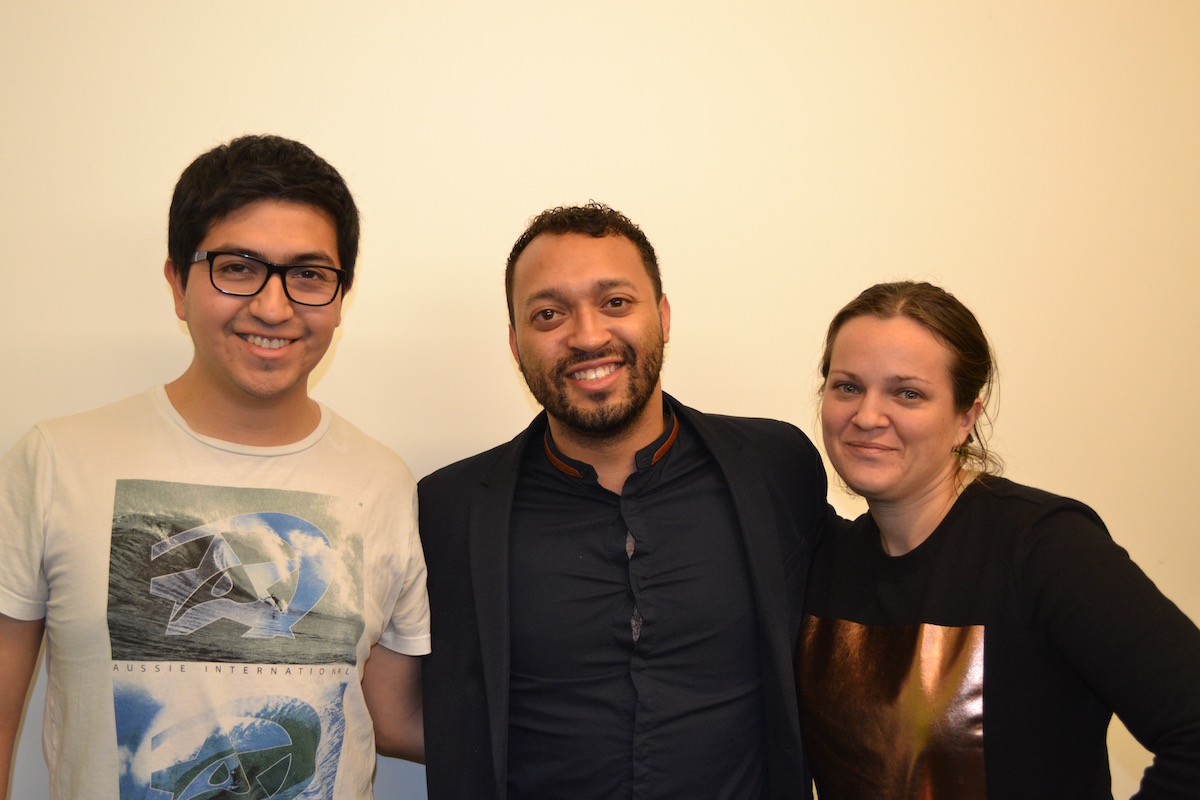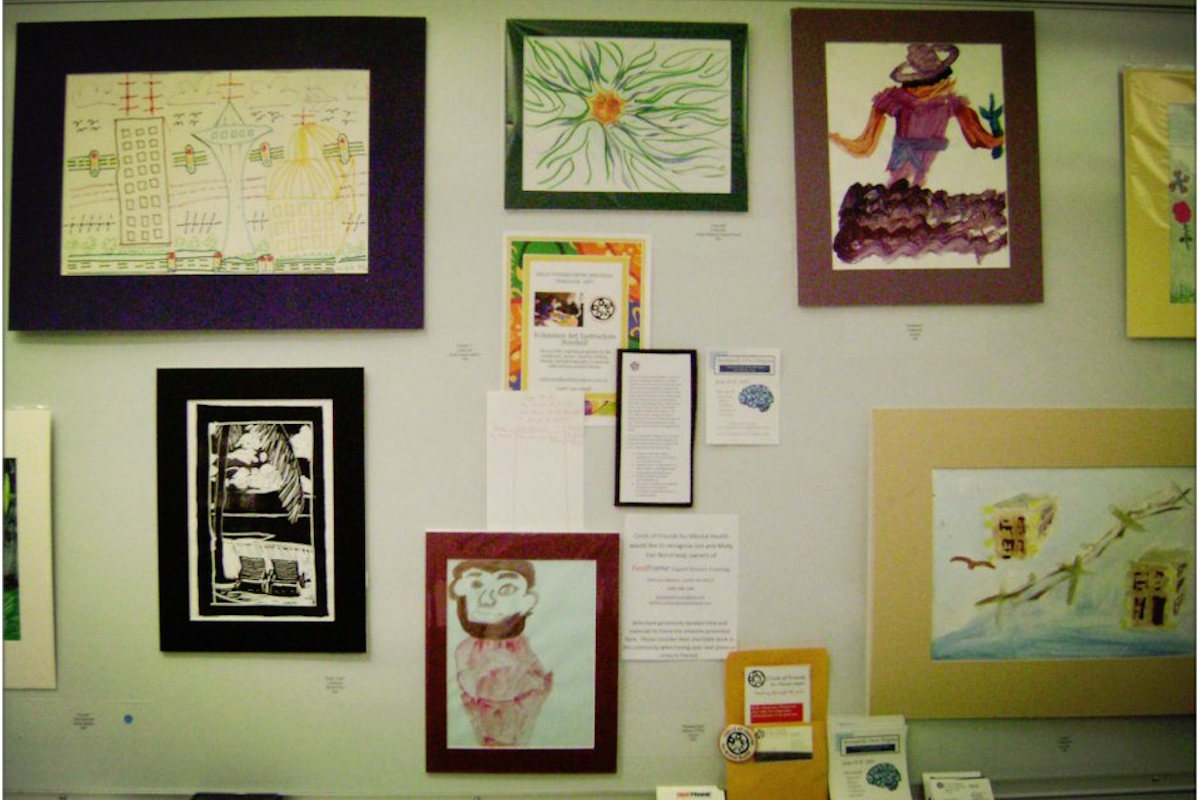Earlier this year, I shadowed a volunteer who teaches creative writing and art classes at the Keystone Adult Learning Center in Fremont, a facility that helps people with a broad range of disabilities lead active lives.
Within the hour, several residents had scribbled stories onto sheets of paper, creating abstract masterpieces with Sharpie markers. In broken English, one woman asked me what I was writing, so I told her about my home in India. A conversation was ignited. As it came time to pack up the markers and say goodbye, she handed me a cartoon drawing of her dog.
The class facilitating expression and sharing is coordinated by Circle of Friends for Mental Health, an organization that brings free art, drumming, creative writing, and movement classes to people in Seattle who are homeless, or struggle with mental health or addiction issues. Geared towards adults of all ages, the organization now provides 10 classes activating creative self-expression at nine locations throughout Seattle.
Under new President and Acting Executive Director Chandler Lewis, who was hired last June, Circle of Friends will expand its programs to reach younger and more diverse service populations as Seattle homelessness spikes.

From early on in life, Lewis was raised to champion creative expression and see its benefits.
“Art activates certain creative areas in our brain that don’t necessarily get stimulated by other forms of activity,” says the 24-year-old.
The son of a celebrated comic artist and nonprofit administrators, Lewis absorbed philanthropy and the arts at a young age, and in 2012, founded his own nonprofit, The Evergreen Project, dedicated to raising awareness about domestic violence among college-age individuals. In the daytime, Lewis works at the Law Office of Katrina S. Zafiro, which specializes in immigration and family law.
His experiences in these roles have led him to believe that many folks stay stuck in a cycle of homelessness because of mental illness or addiction.
“The issues that Circle of Friends addresses — homelessness, mental health, addiction — are all combined,” Lewis explains.
Raised knowing the value of art-making, he wanted to build a community around bringing the same creative opportunities to those marginalized by mainstream society. Art-making has also been proven to help alleviate symptoms of alcoholism, says Lewis.
Adding diverse perspectives
To enrich Circle of Friends services, Lewis aims to widen areas of knowledge by bringing in different global perspectives.
One way Lewis has achieved this is by partnering with AIESEC, a nonprofit that appoints young talent and volunteers from all over the world in local positions of leadership and service in the U.S.
“I want there to be a cultural exchange between us and the students,” says Lewis.
Currently, 55 percent of the Circle of Friends staff is female, and 85 percent of those holding leadership or administrative positions are people of color, with more than 30 percent being foreign-born or first-generation American. The team also includes 38 registered volunteers, including students from universities acting as Circle of Friends teachers. More than half study psychology or social work.
Krisztina Kapuvari is one such AIESEC exchange participant from Hungary, currently fulfilling a full-time internship with Circle of Friends. In early February, she started teaching a new visual arts class at Mary’s Place in downtown Seattle, a daycare center for homeless women, children and families.
“Because of my accent, students immediately ask me where I am from. I then ask them back, and in this way a discussion is started,” says Kriszti.
She finds that such discussions about one’s background often work as icebreakers and make students more comfortable sharing their own unique stories with teachers and volunteers.

With about 10,000 people a night sleeping in the streets, in homeless shelters or transitional housing, Seattle has one of the most severe homelessness crises in the nation. This offers a dramatic point of contrast for AIESEC staff from other places.
“I’ve never seen so many homeless people in one city,” says Luis Felipe Catrilef Valle, an AIESEC intern from Chile who volunteers with Circle of Friends at Seattle’s Downtown Emergency Service Center.
According to Catrilef Valle, his home city of Santiago has a population of 6 million people and only 6,000 of them are homeless, as compared to relatively large proportion in Seattle’s much smaller population of 684,451.
“To find that homelessness is more visible in Seattle than in South America is eye-opening,” says Lewis.
Reaching young folks

Since the start of the year, the organization has already added two new visual art classes – one at Mary’s Place and another at Jubilee Women’s Center.
After recently being awarded a two-year Arts Sustained Support grant from King County’s 4Culture, Lewis also plans on diversifying Circle of Friends with more innovative programming, distributing a quarterly zine showcasing student work for a small subscription fee, as well expanding adult-focused programming to 14-to 24-year-olds downtown with a new street-graffiti art project. He says that mural art therapy has proven to reduce stress in adolescents. Circle of Friends is in the process of securing a wall space for this large-scale project and also hopes to provide students with the materials to paint small-scale murals to keep.
More programming for young people is also in the works at Seattle World School, where they’re currently designing a holiday and after-school arts program.
This Thursday, April 13, Circle of Friends hosts their annual fundraising gala to raise more support for expanding programs.
Growing need
According to Lewis, people who have hitchhiked all over the country come to Seattle because they think they can find a job, get funded into transitional housing here, and access more resources. So, it becomes the responsibility of an organization like Circle of Friends to do as much as they can to supplement their needs with inclusive and community-focused spaces, he says.
With President Trump trying to defund arts programming, Lewis and Circle of Friends are also fighting an assault on the arts.
At his day job at an immigration firm, Lewis interacts with post-election stress every day.
“Being on the streets, there’s a much higher risk of being stopped and asked for documentation,” says Lewis.
Through Circle of Friends, he wants services to reach students regardless of documentation to help them reach their best potential.
“Spaces are completely open, and if you are a human, that’s all you need to access our services,” says Kriszti.
Kriszti has found that resources among social service agencies she works with run thin: Mary’s Place has no art supplies to give residents the creative stimulation they need. Moreover, other organizations require payments or proof of illness or addiction before they can provide their services to facilities.
Circle of Friends is the only organization in Seattle that provides arts programming and supplies to homeless or mental health-struggling individuals without documentation or pay.
“Through art, people are able to escape or cope with their realities,” says Lewis. “I can’t think of any other way for people to experience this kind of healing.”
As Lewis leads the organization through a federal funding and homelessness crisis, the need for a safe space to tell one’s story grows in importance. Whatever language we speak or struggle in, sharing stories through Sharpie-penned masterpieces or drumming can be a powerful, universal exchange.
Circle of Friends for Mental Health will host their annual fundraiser on Thursday, April 13 from 6 p.m. to 9 p.m. at Sole Repair Shop in Seattle’s Capitol Hill neighborhood. For more details, visit their event page.

